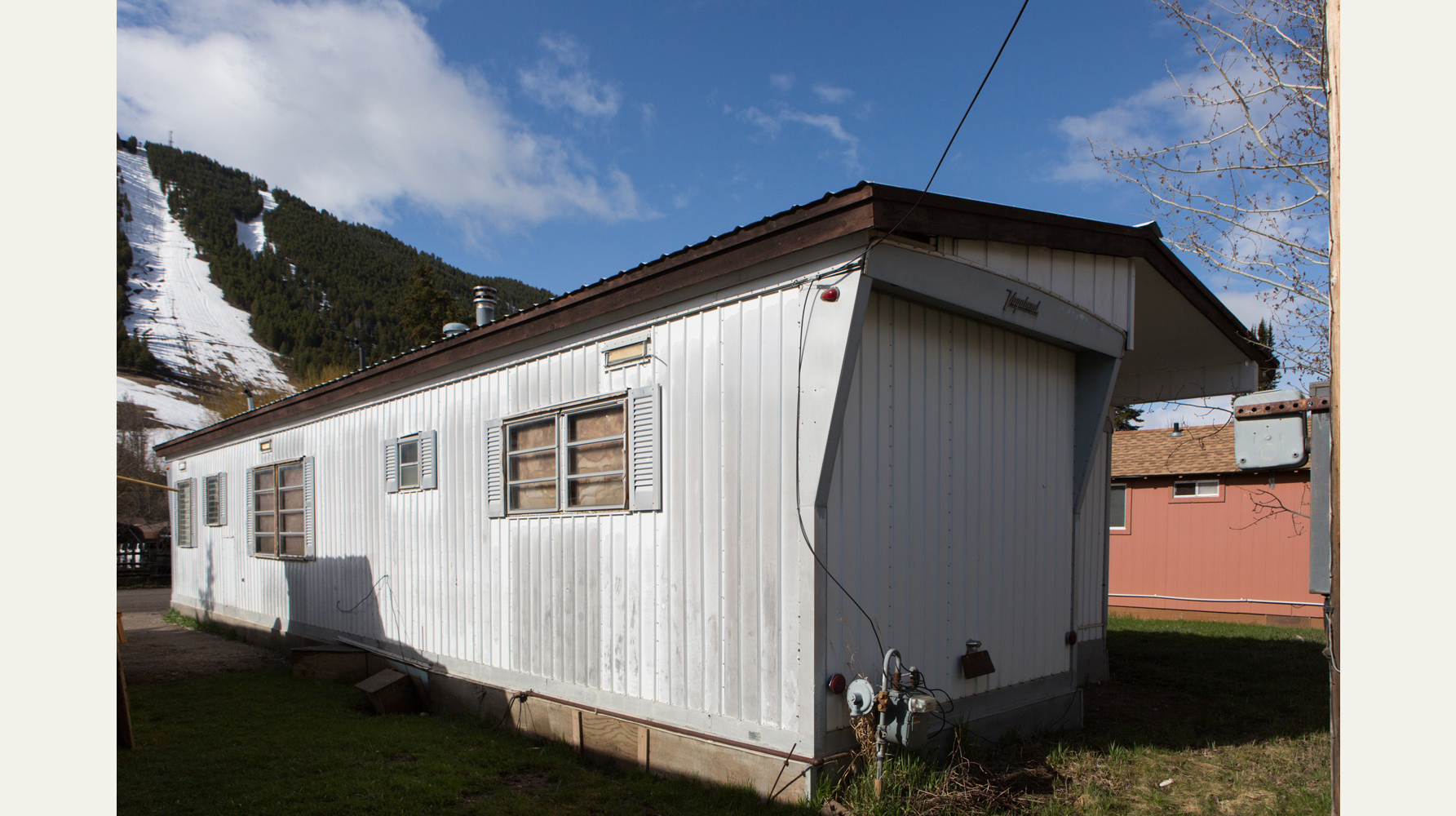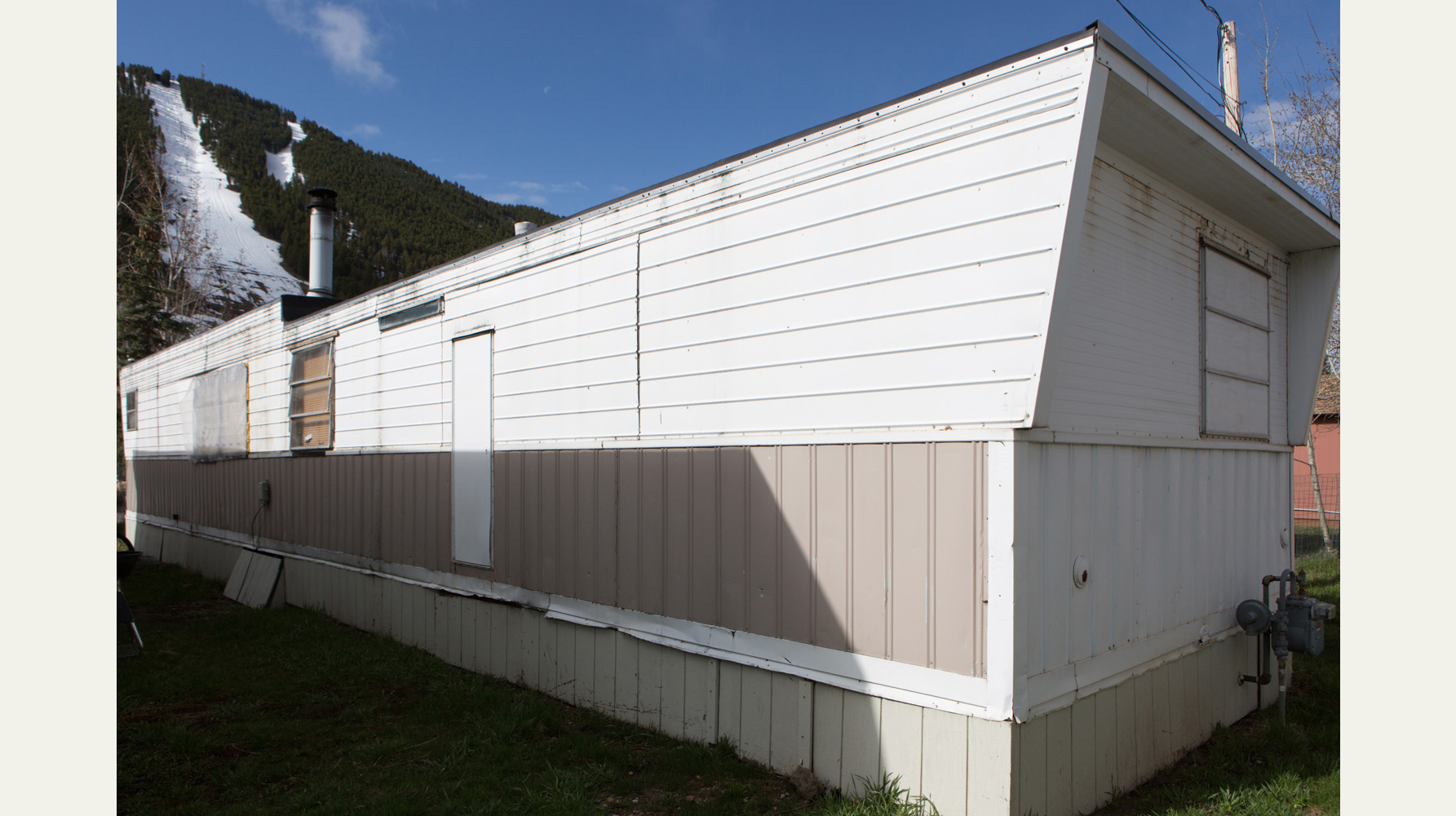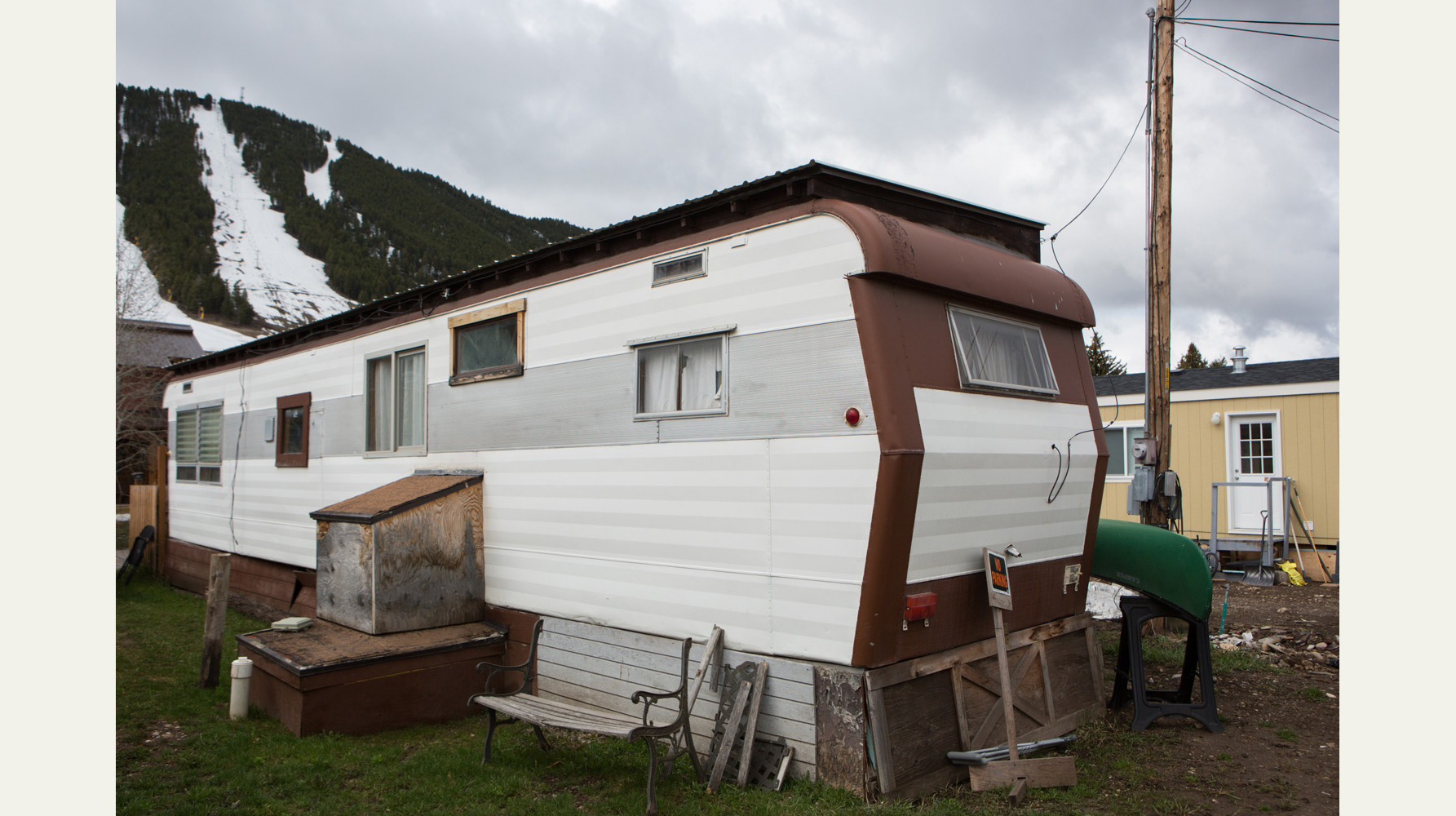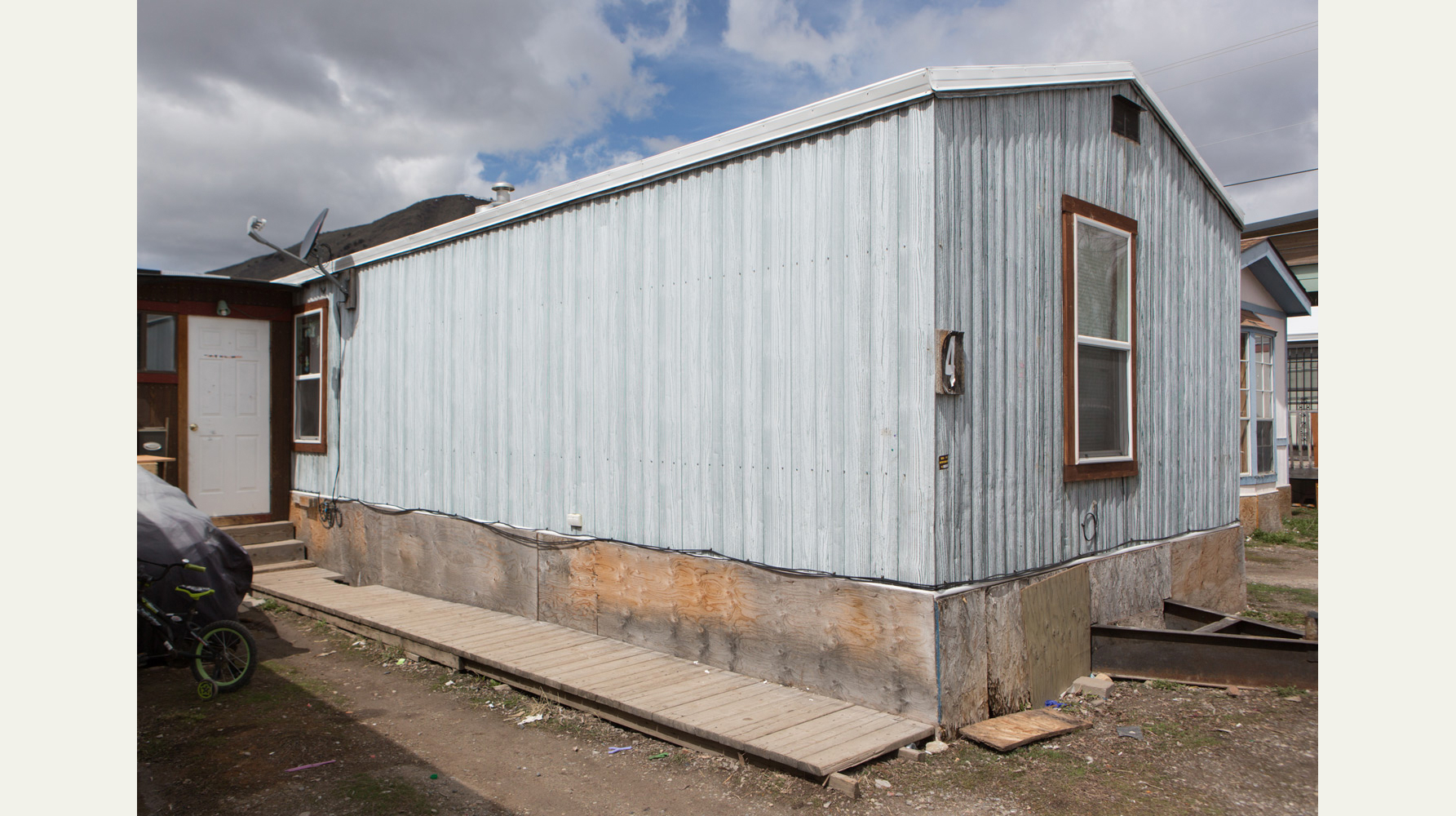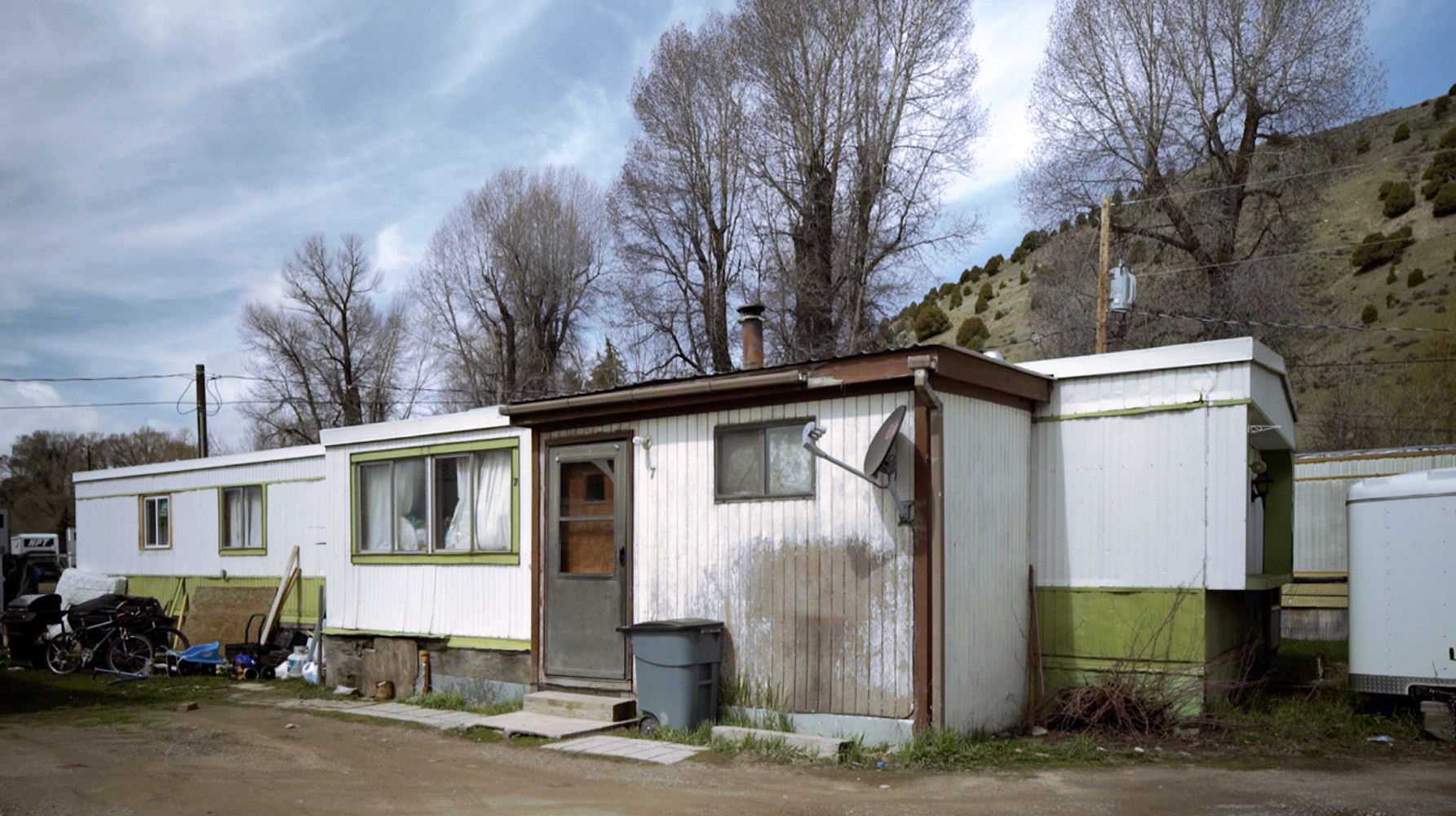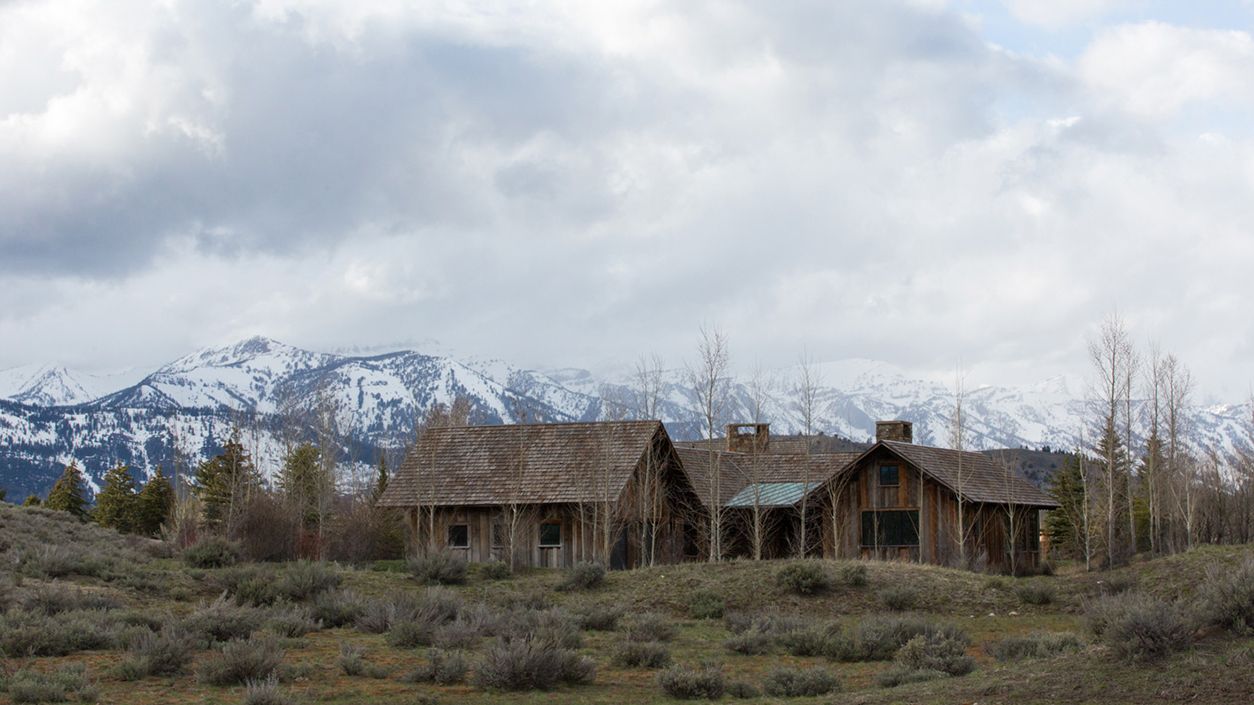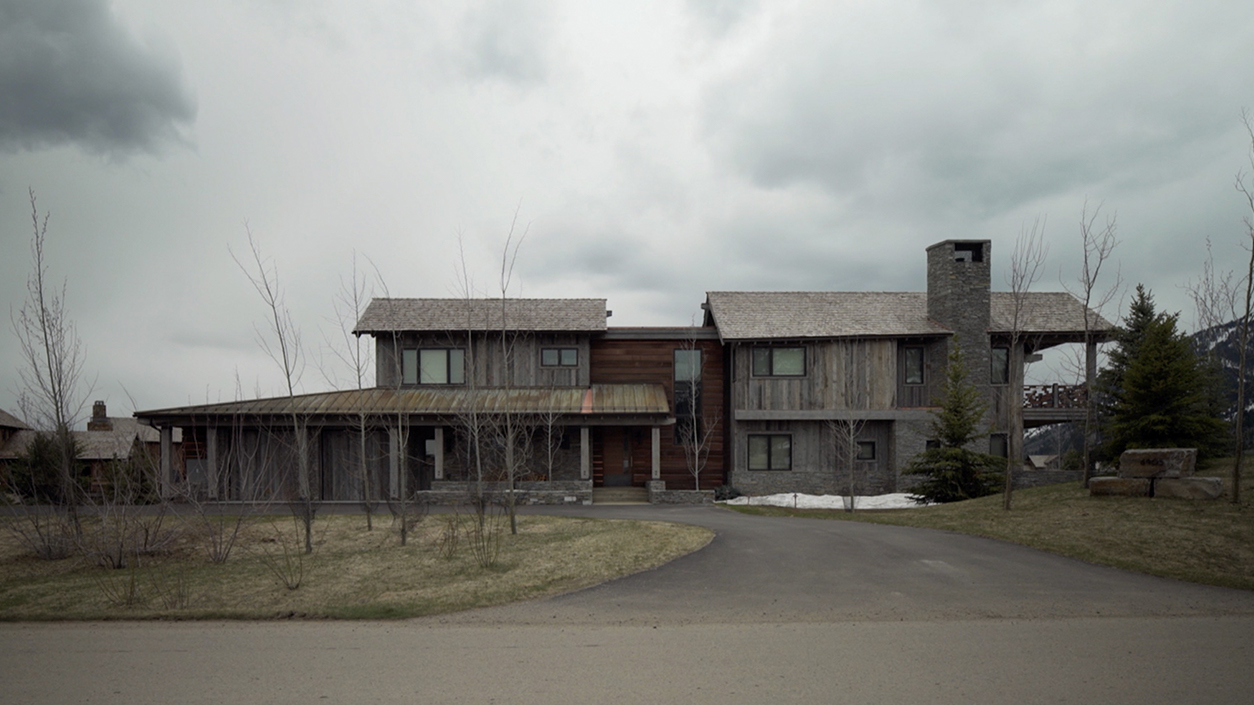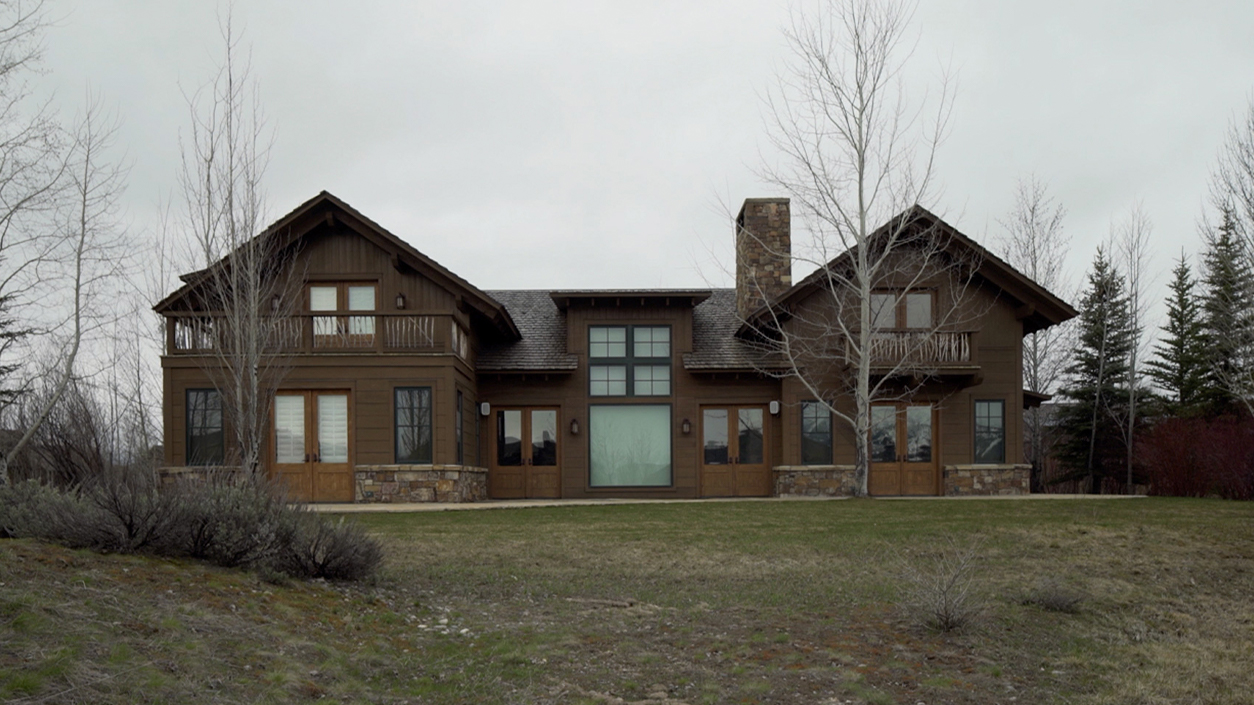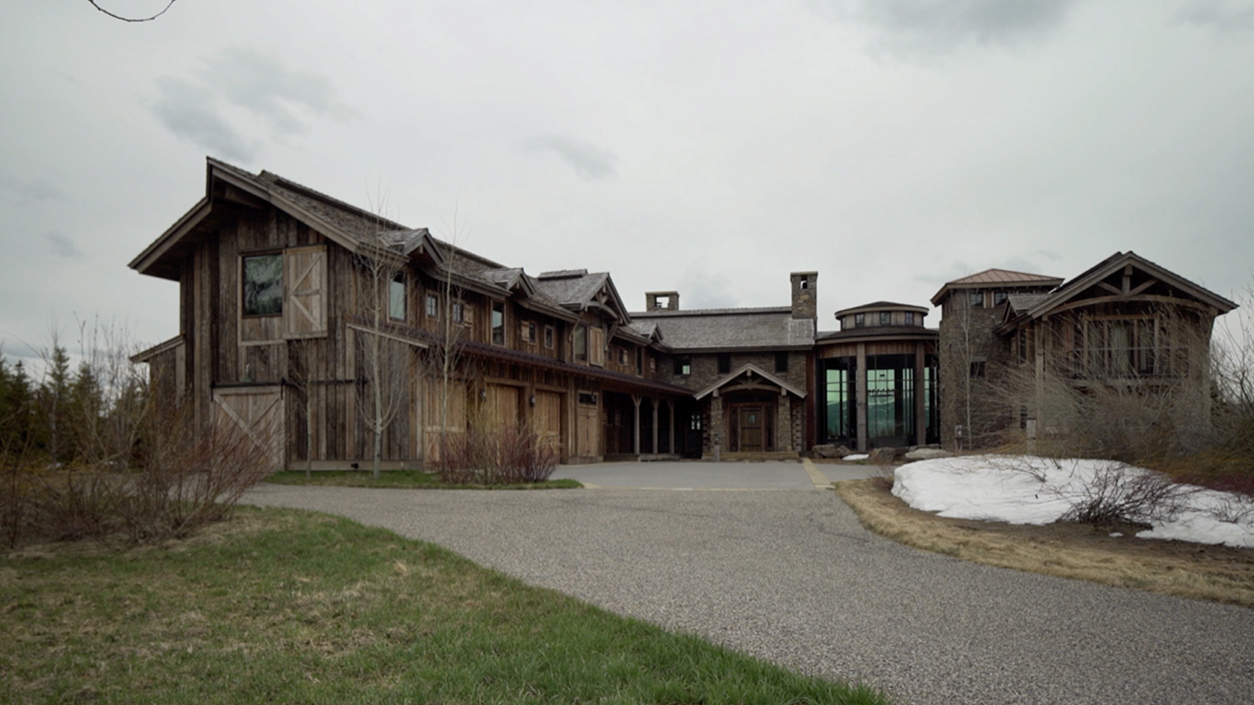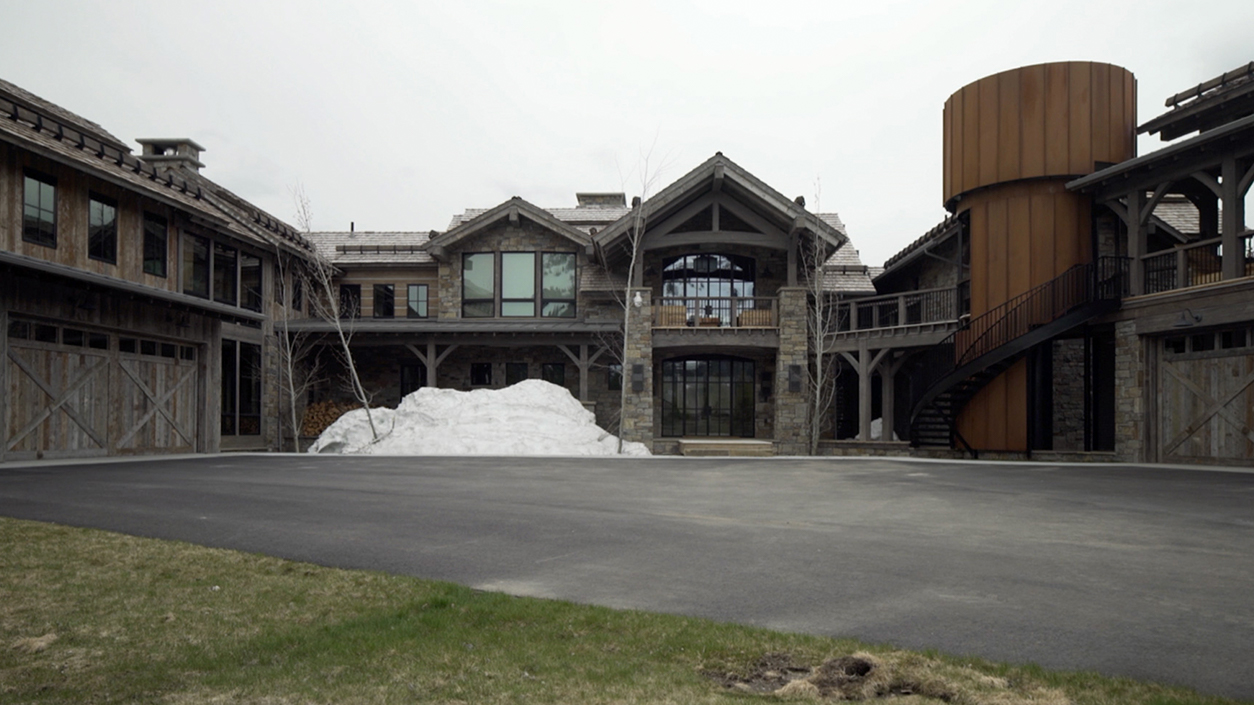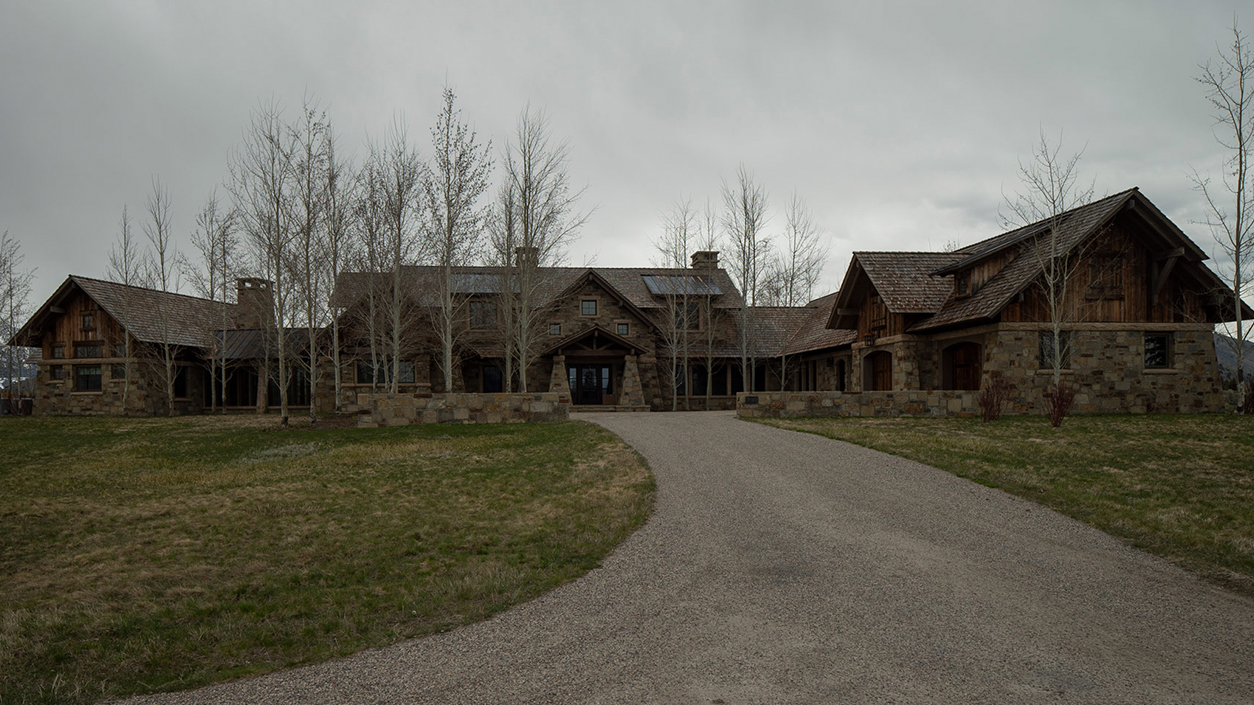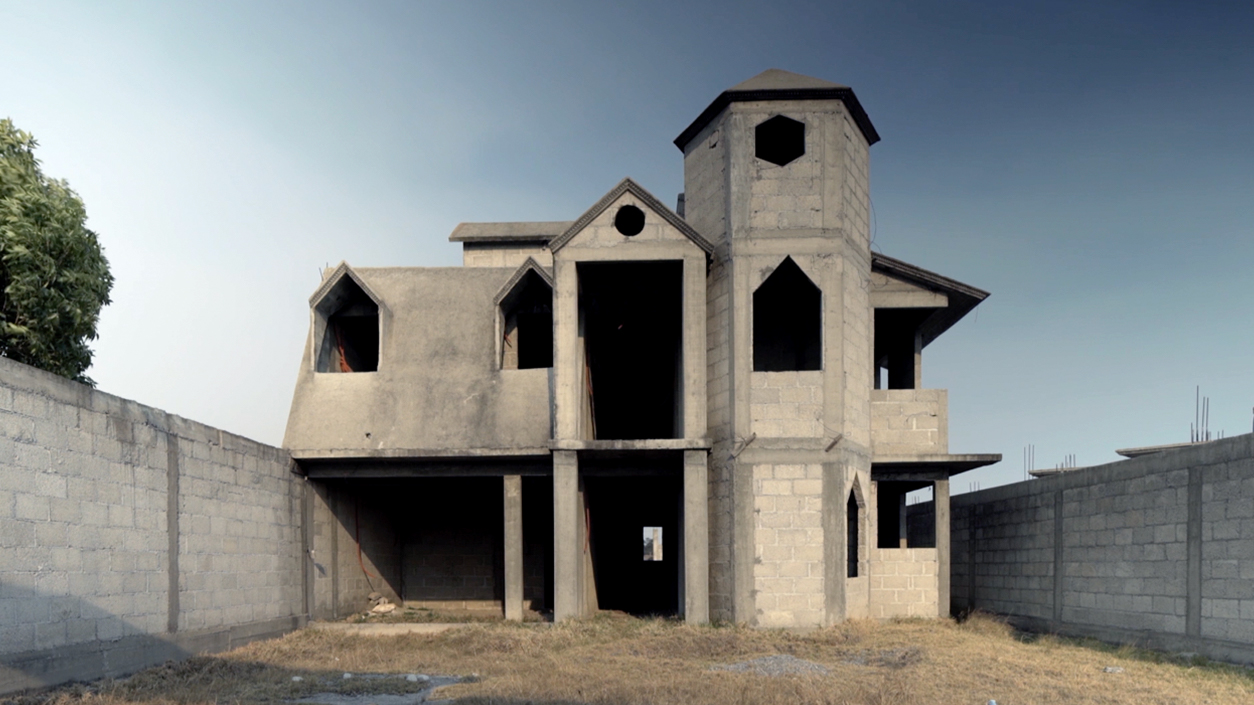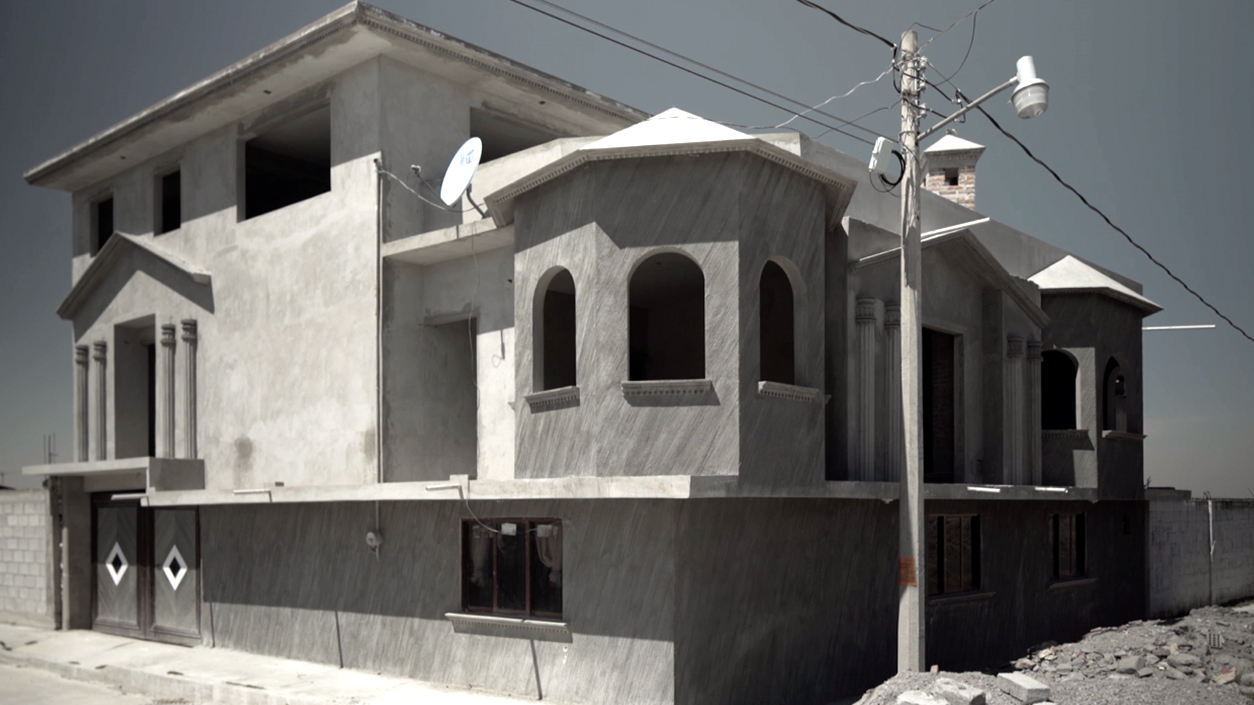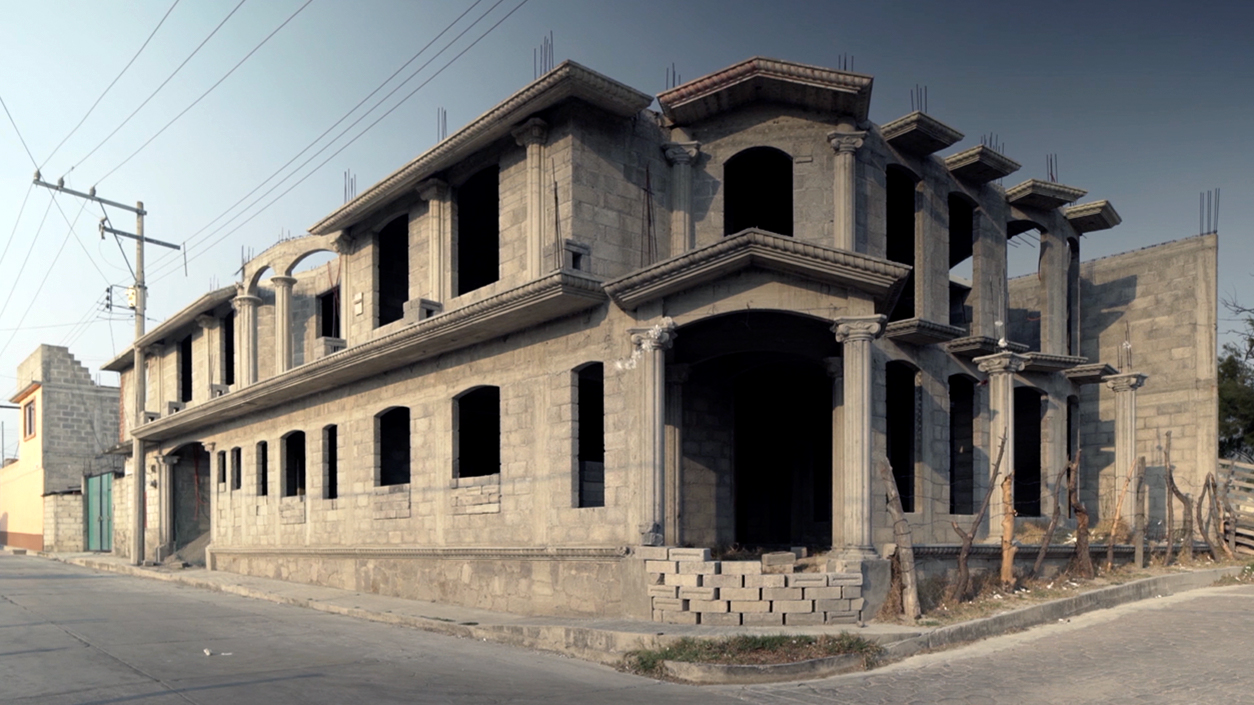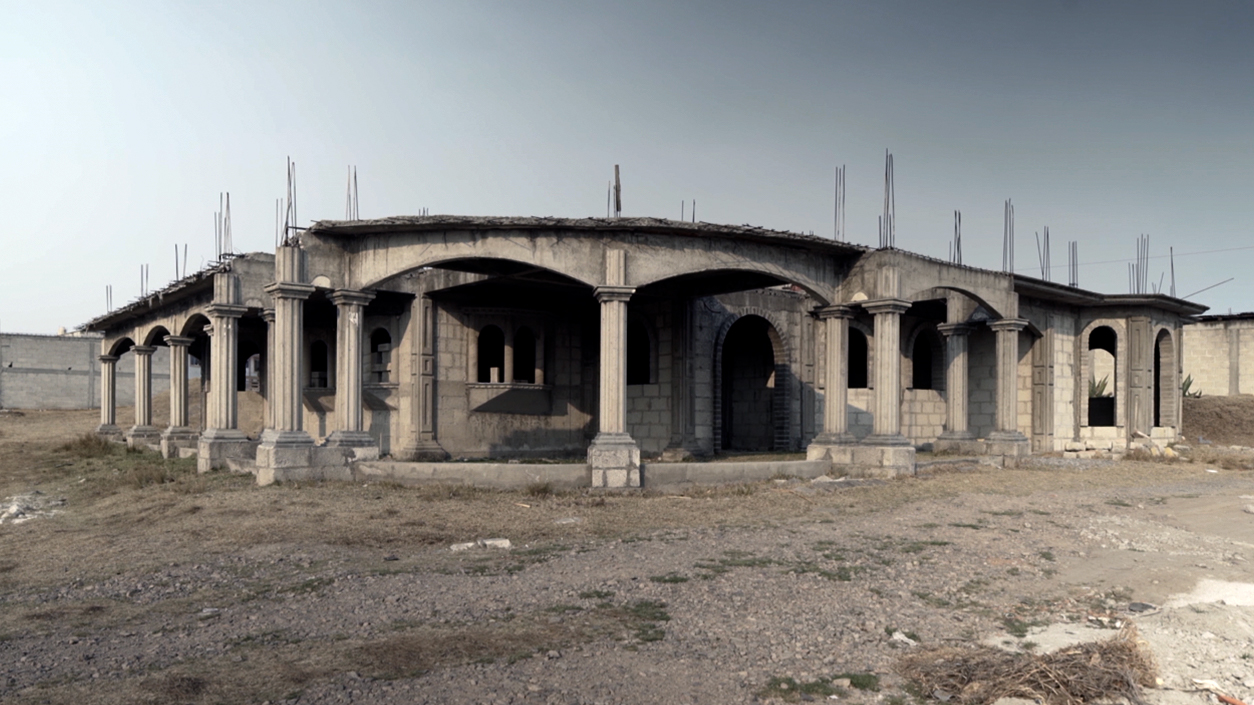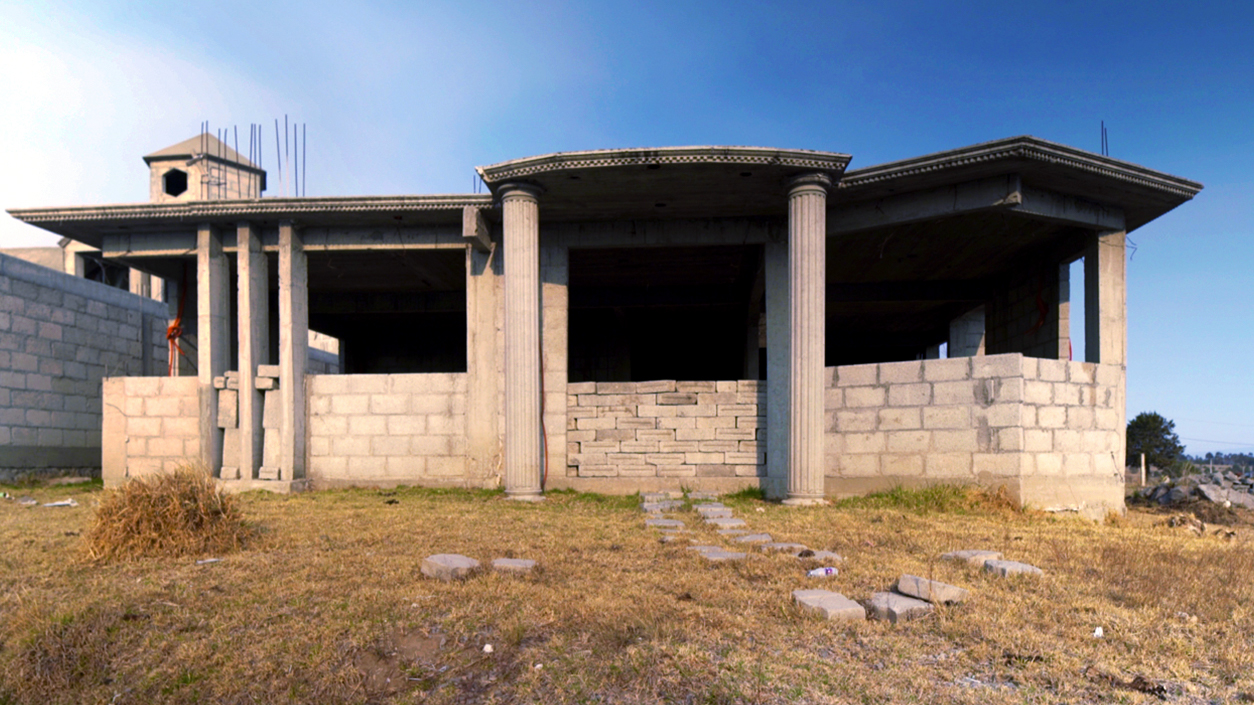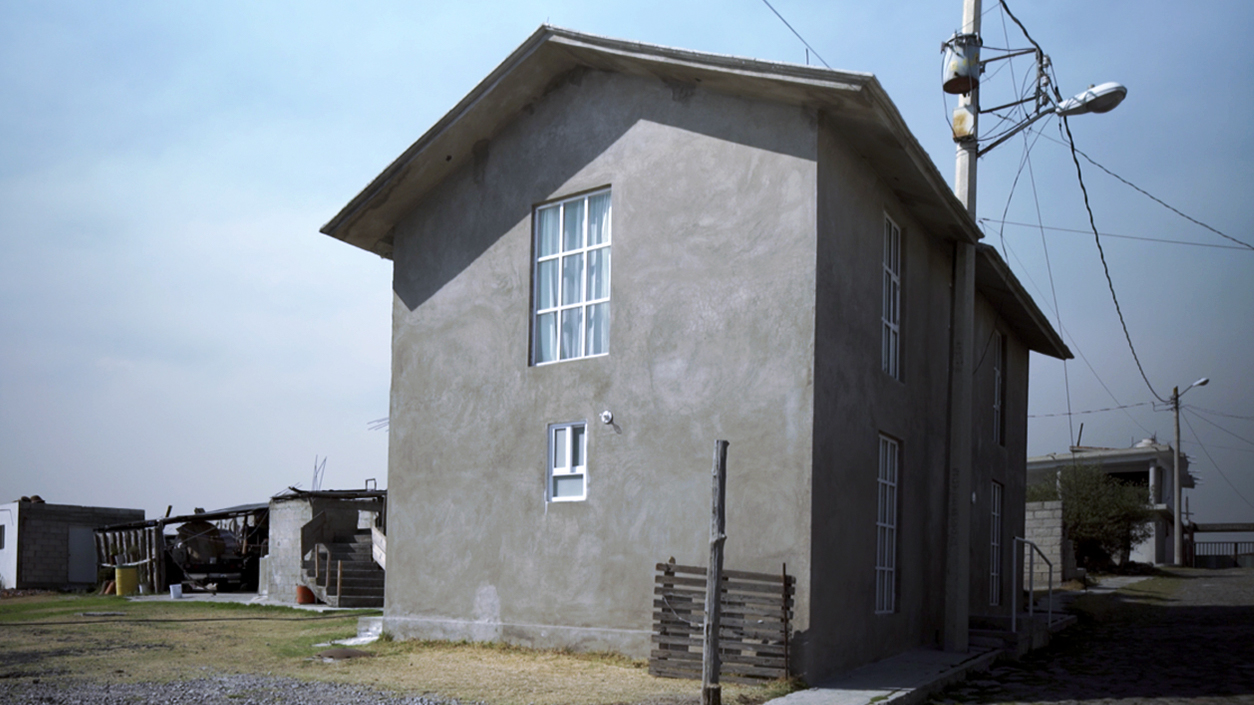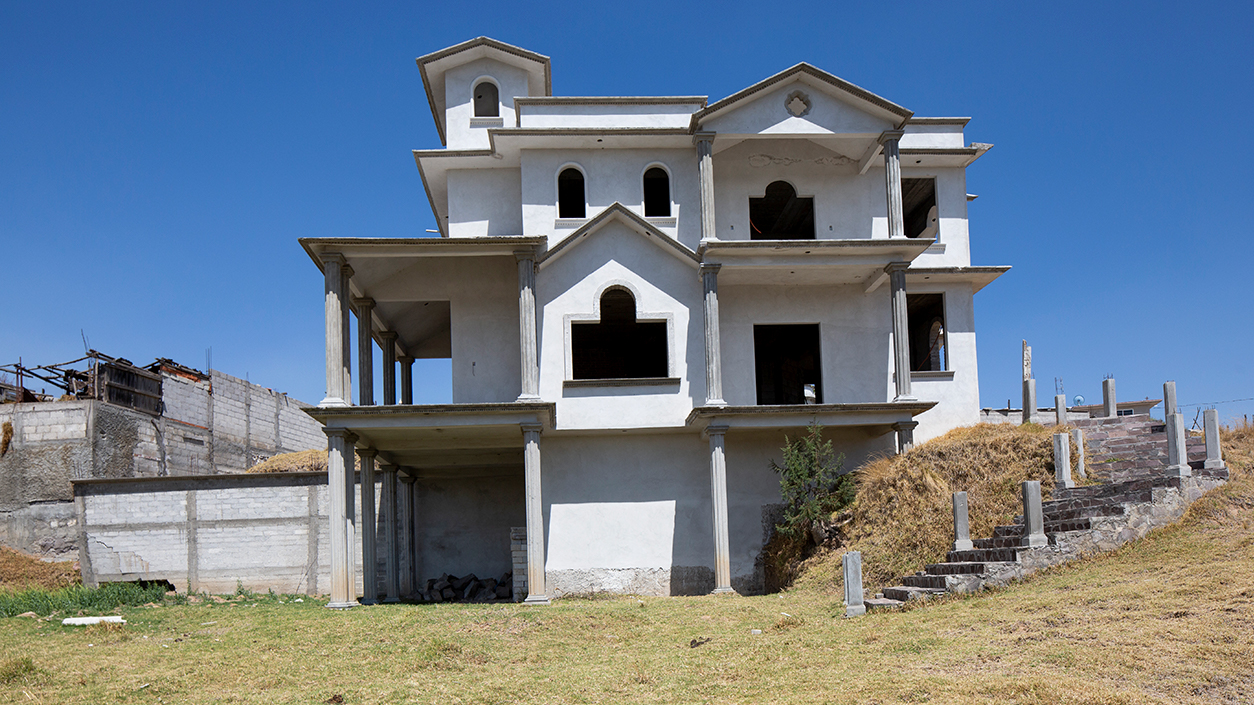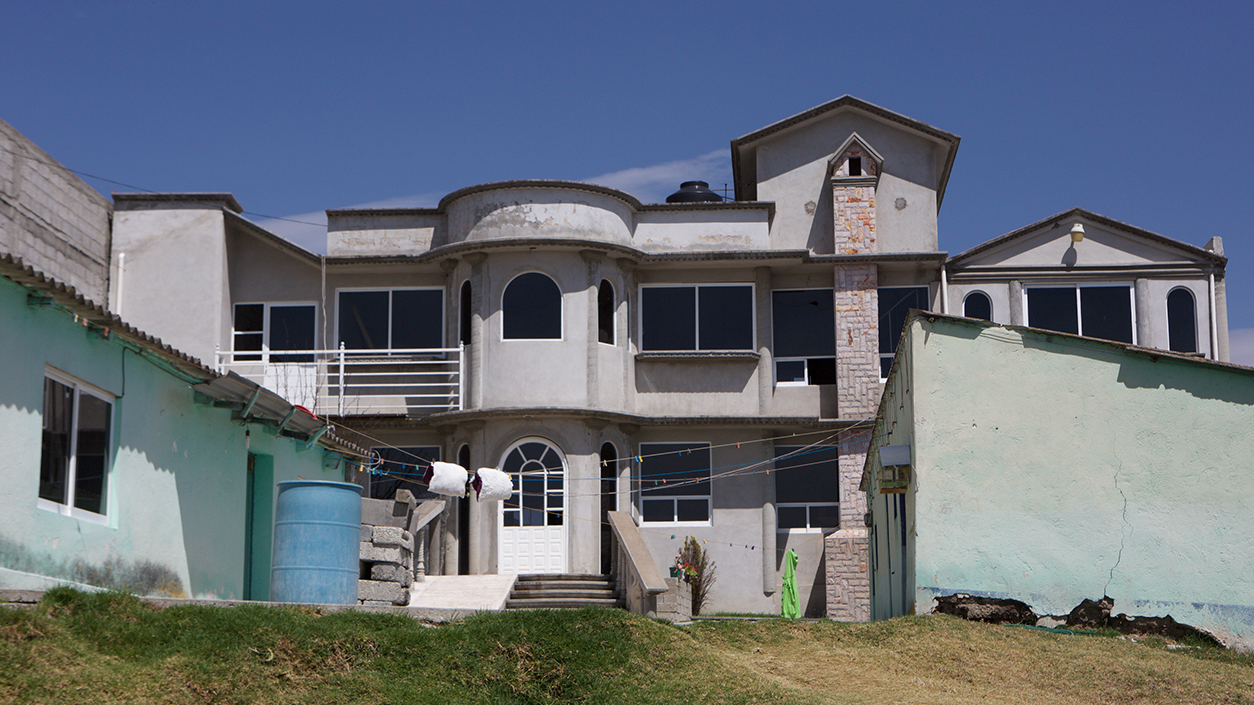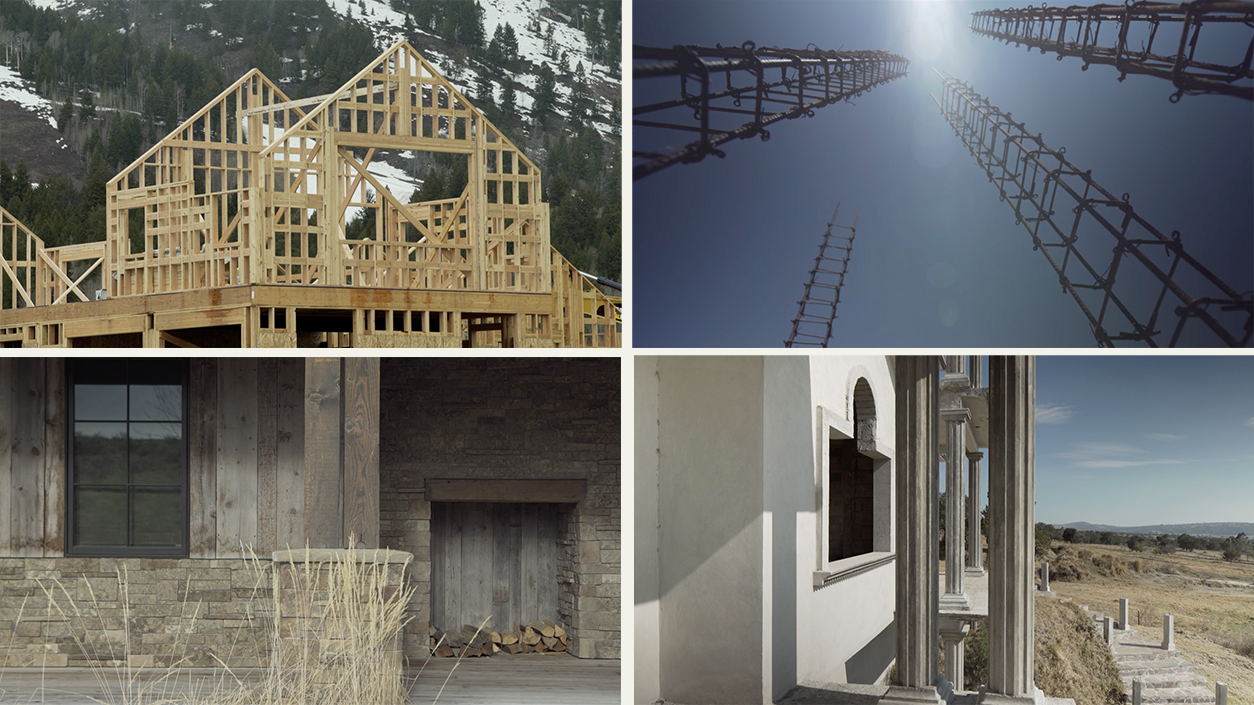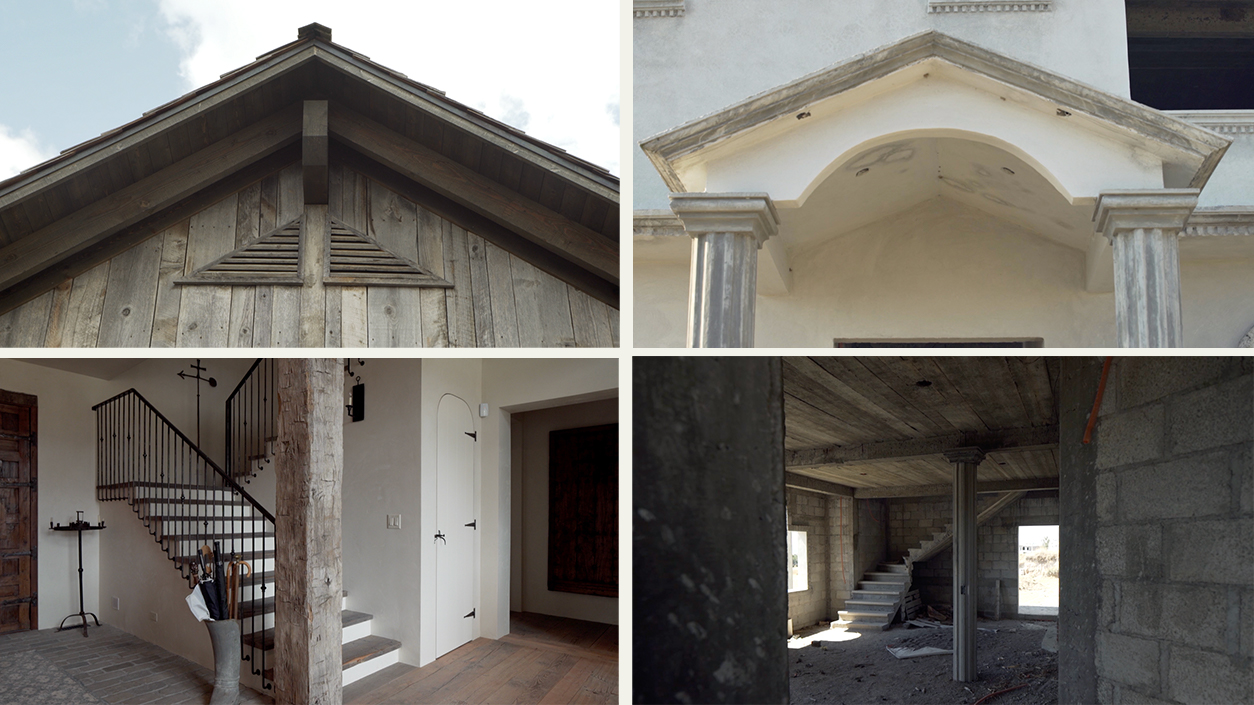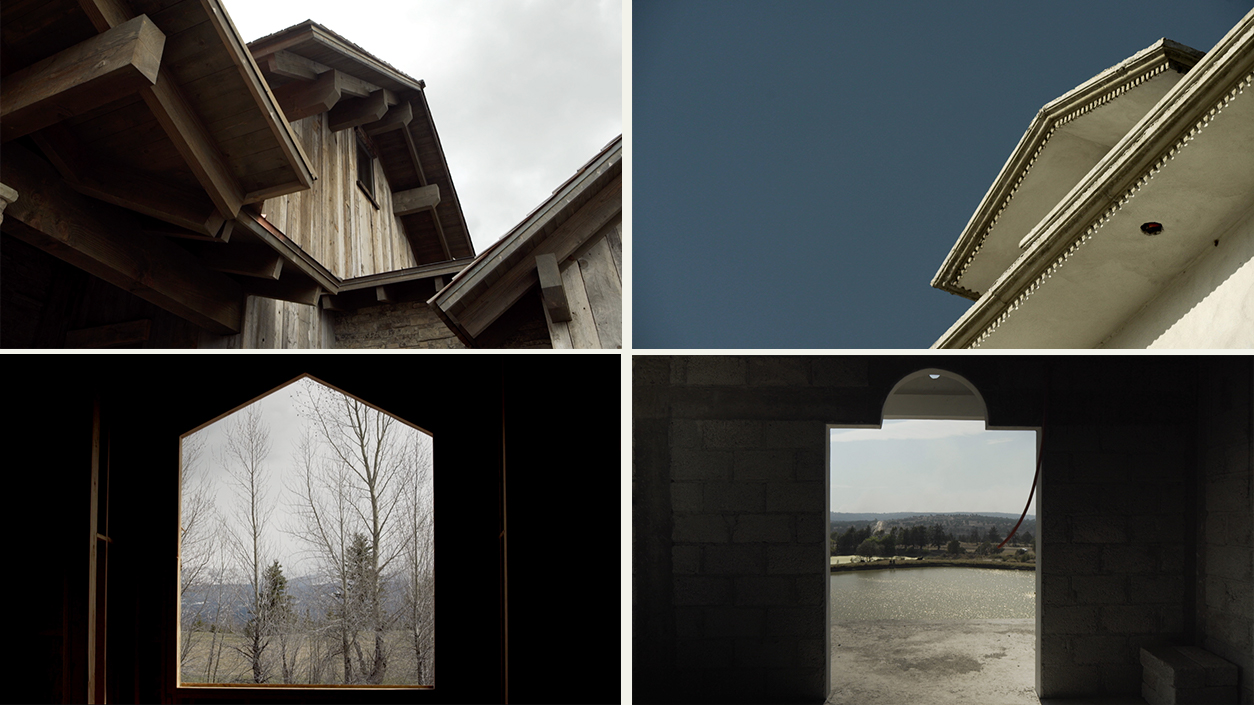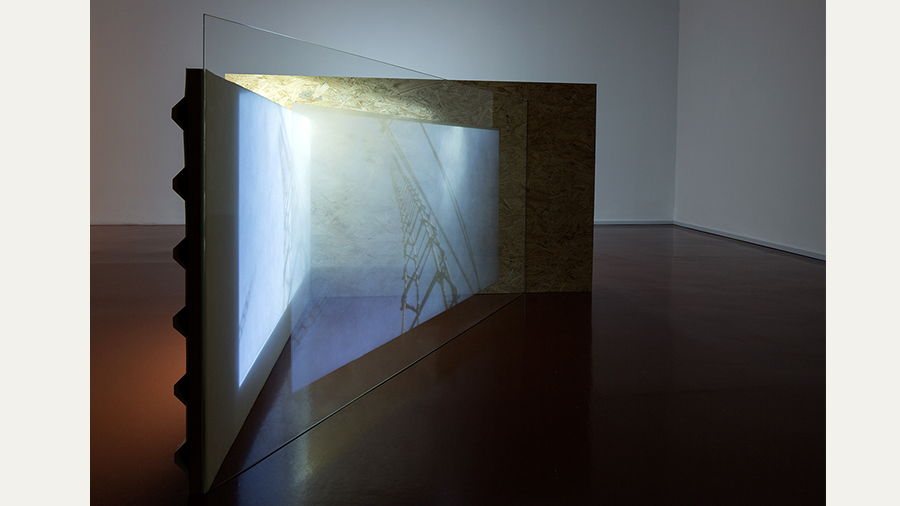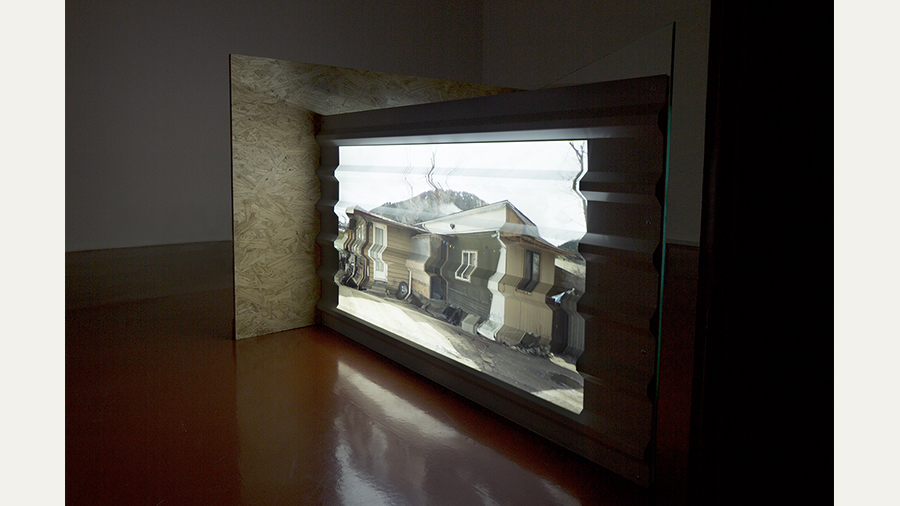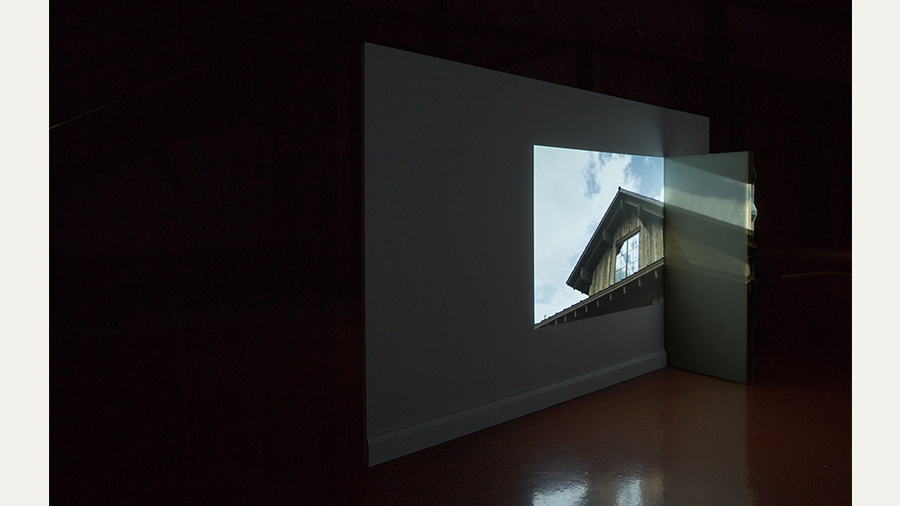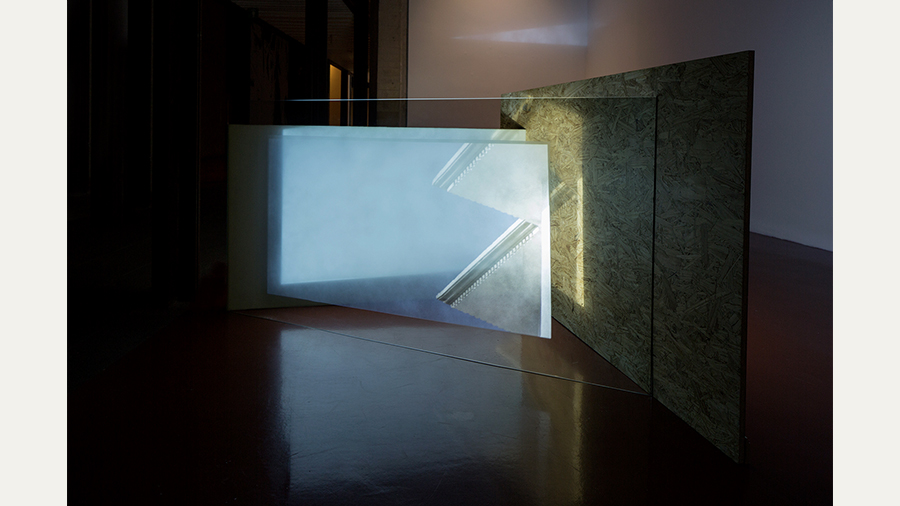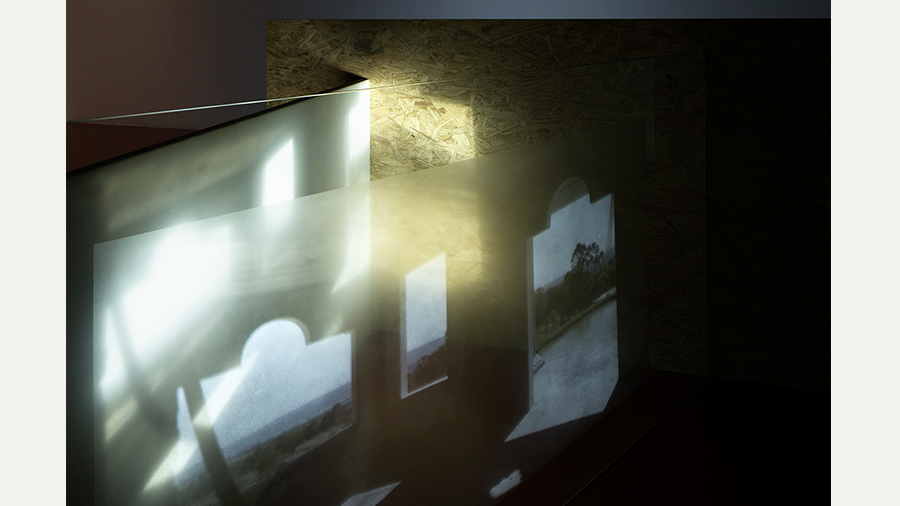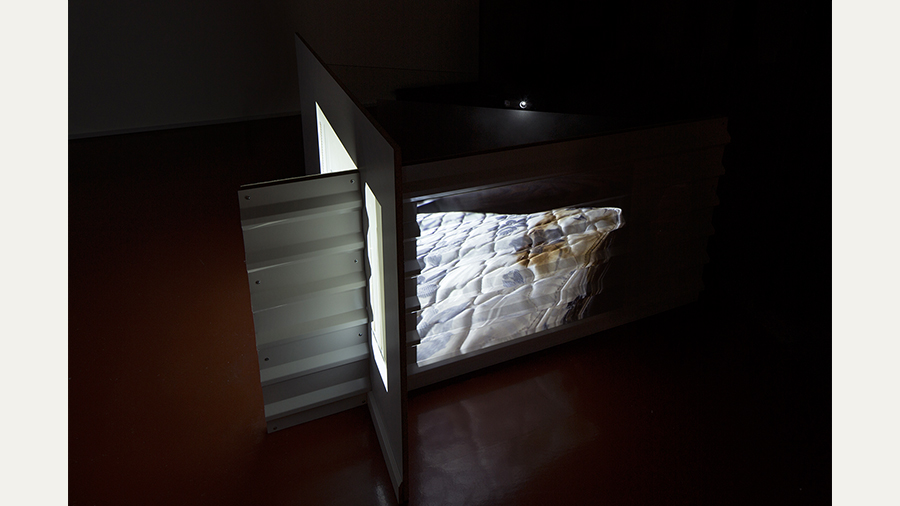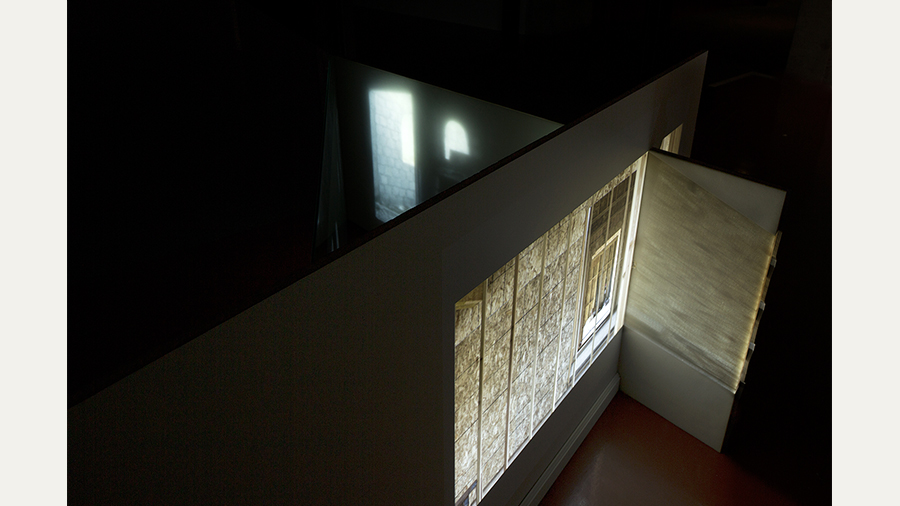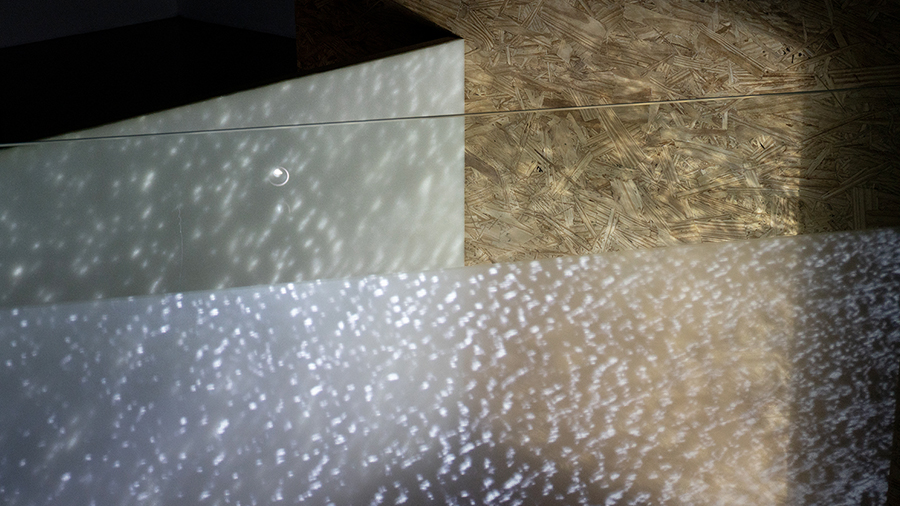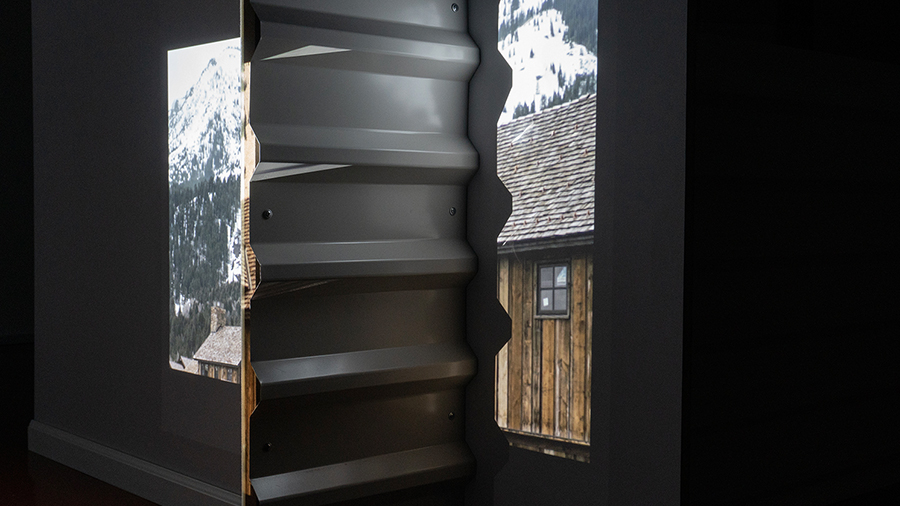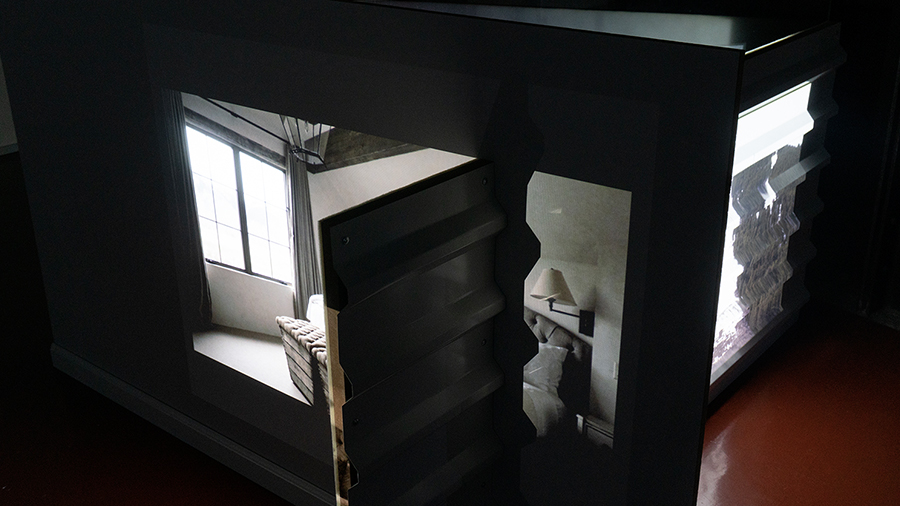Copias del abandono es el reflejo vital de la arquitectura de la migración entre México y Estados Unidos. Muestran las diferencias y similitudes de las maneras de vivir en los dos países, las aspiraciones individuales, las realidades crudas, la forma en que los modelos arquitectónicos se transforman a través de ópticas particulares y a su vez cómo estos modelos transforman las sociedades en las que se insertan.
En este ejercicio se comparan tres momentos de habitación permanente o temporal en el recorrido de los migrantes que van de Hueyotlipan, Tlaxcala a Jackson Hole, Wyoming, ciudades hermanas.
LA CASA HABITADA: los sitios que habitan los migrantes mientras trabajan en Jackson Hole.
LA CASA MODELO: las casas que los migrantes construyen a la comunidad adinerada de Wyoming.
LA CASA SOÑADA: las casas que los migrantes construyen en su lugar de origen, por las que ahorran y mandan remesas a sus familias.
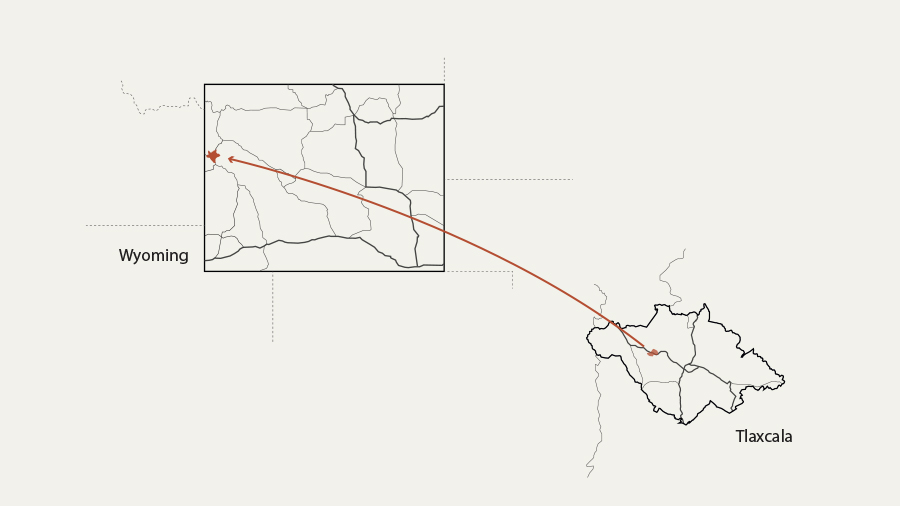
La migración al norte sigue siendo un resultado de la desigualdad y violencia que se vive en el país. Los mexicanos son todavía el grupo más grande de migrantes radicados en Estados Unidos, su desplazamiento continuo a través de varias generaciones ha generado lazos geográficos entre las localidades expulsoras y receptoras. Por ejemplo, el 80% de los latinos que residen en el estado de Wyoming son originarios del estado de Tlaxcala, y en particular del municipio de Hueyotlipan. Ejemplos como este se reproducen a lo largo de todo el territorio nacional originando grupos con una asociación cultural de origen que deciden migrar a los mismos puntos, tal es el caso de Puebla - Nueva York; Tulancingo - Salinas CA, entre otros.
El proyecto se centra en reflexionar sobre los paralelismos arquitectónicos de las casas donde los migrantes trabajan en Estados Unidos, y las casas que construyen con remesas en sus localidades de origen. Una muestra de la constante lucha por construir una casa propia, y de los lazos de añoranza y arraigo que los migrantes mantienen con sus familias y sus comunidades aun después de años de vivir en el extranjero. Una vida de hacinamiento, en condiciones de extrema precariedad, trabajando en servicios y construcción, mientras que con sus ahorros autoconstruyen palacetes inspirados en mansiones.
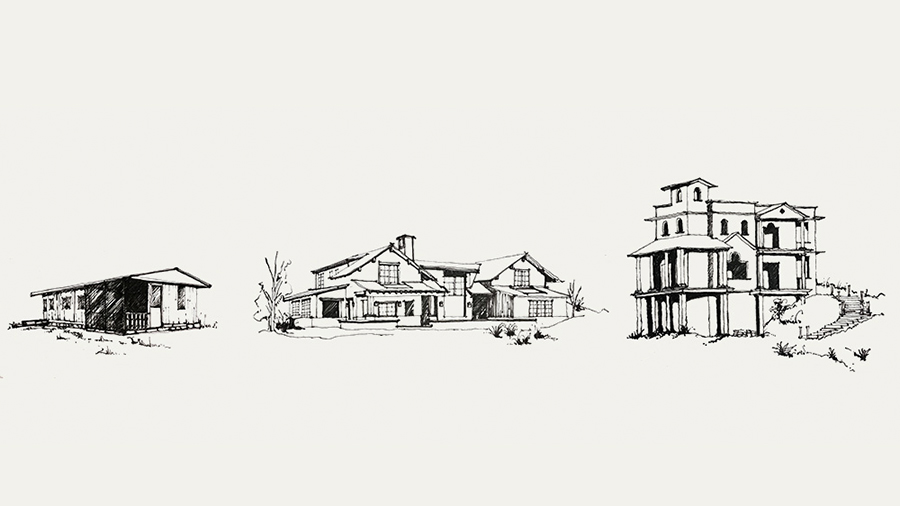
El diseño de estas casas no se delega a un especialista, son los habitantes y sus familiares los propios arquitectos, se produce una libertad particular que termina por afectar hondamente la estructura de la casa. El hecho de que no haya arquitectos no significa que no haya arquitectura. Este juego arquitectónico trabaja sobre la posibilidad de modificar y autoconstruir. Los espacios se mantienen en permanente apertura, un estado de ambigüedad donde no se sabe si la casa se está construyendo o se está abandonando, un ejercicio que se modela bajo la marcha, respondiendo a la intuición y las aspiraciones de sus dueños. El ideal de una casa que quizá nunca lleguen a habitar, pero cuya construcción les motiva y les complace, responde a la necesidad de pensar e imaginar una vida distinta a la que realmente existe. Este fenómeno se reproduce en múltiples puntos del país, una arquitectura que responde a realidades económicas y globales, donde se da prioridad al flujo de capital económico a expensas del movimiento humano. Estas son las construcciones utópicas reflejo de un abandono, de un territorio, de una familia, de un paisaje despojado.
El proyecto abarca diez casos de estudio, de los cuales se seleccionó, como muestra, el caso específico del migrante Abraham Hernández Bautista. El proyecto in extenso incluye un documental y un archivo (planos, diagramas, fotografías y textos).
Abandonment Copies is a vital reflection on the architecture of migration between Mexico and the United States. A comment on the differences and the similarities between the ways of living and inhabiting in both countries: the individual aspirations, the crude realities, and the way architectural models can be translated through the particular lens of the society in which they are inserted.
The project compares three moments of permanent and temporary habitation between Hueyotlipan, Tlaxcala and Jackson Hole, Wyoming, (sister cities)
THE INHABITED HOUSE: The places that immigrants inhabit while working in Jackson Hole.
THE MODEL HOUSE: The houses immigrants build for the wealthy community of Jackson Hole.
THE DREAMED HOUSE: The houses, immigrants build in their place of origin, for which they save and send remittances to their families.

The migration to the north continues to be one of the results of the ongoing inequality and violence that exist in Mexico. Mexicans are still the largest community of immigrants living in the United States. The result of years of continuous displacement of people throughout several generations was the emergence of a geographical tie between the sending and the receiving communities in both countries. For example, 80% of the Latinos residing in the State of Wyoming are native to the Mexican State of Tlaxcala, in particular from the municipality of Hueyotlipan. Examples of this can be found throughout the Mexican - USA territory. Communities formed in foreign lands that hold a cultural association of origin, such is the case of Puebla - New York; Tulancingo - Salinas, CA. among many others.
The project focuses on the architectural parallelisms between the three types of housing. The places where the immigrants live, the houses where they work, and the houses they build back in Mexico. The work shows the constant struggle to build a house of one’s own, and the ties of longing that immigrants maintain with their families and their native communities even after years of living abroad. A lifetime of endurance, living overcrowded in extremely precarious conditions, working illegally in services and construction, to send money savings back to Mexico; where their family members construct self-built mansions inspired by the mansions the same immigrants helped to erect in Wyoming.

In a self-built dwelling, the essence of the house is not delegated to a specialist, which allows the families the particular freedom to (re)define and build the space as they wish. To have that liberty radically and profoundly affects the structure of these houses, however, the fact that there are no architects does not mean there is no architecture. The spaces are kept in a perpetual open modus, a state of ambiguity, where it is not possible to know if the house is being built or being abandoned. The practice of building is forged on the go, responding to the intuition and the aspirations of the owners. An ideal of a house that they may never inhabit, but whose construction motivates and pleases them. This is a response to the need of imagining a life different from one’s reality. A phenomenon that is reproduced throughout Mexico. An architecture that emerges from economic and global demands, where priority is given to the flow of economic capital at the expense of human movement. These are the utopian constructions that mirror the abandonment of a territory, a family. A stark and bare landscape.
The project covers ten case studies but herein the case of the Mexican immigrant Abraham Hernández Bautista was selected as a sample. The extensive project includes a documentary, and an archive (blueprints, diagrams, photographs, and texts).
ENSAYO VISUAL VISUAL SINOPSIS
LA CASA HABITADA THE INHABITED HOUSE
Las casas habitadas son los remolques, cuartos de motel o sótanos, donde viven los migrantes, lugares donde las amenidades son precarias, destinadas a cubrir las necesidades más básicas. Las personas por lo general comparten el espacio entre dos o tres núcleos familiares con lazos de parentesco o trabajo, donde los integrantes en muchas ocasiones se ven obligados a rotar la cama. Asentamientos irregulares bajo la constante amenaza de desalojo, lugares concebidos como temporales que se convierten en sus casas a largo plazo, viviendas inestables y aisladas donde las rentas son altas y representan la mayor parte de sus ingresos.
The inhabited houses are the trailers, motel rooms, and basements where the immigrants actually live. Precarious places that are supposed to cover their most basic needs. Houses that are usually overcrowded, shared between two or three nuclear families —which are either part of the same extended family or related by work to each other. Places where the family members are many times forced to share or rotate the use of beds. Irregular settlements under constant threat of eviction; places conceived as temporary that become long-term homes, unstable and isolated households with high rents representing more than a third of the tenants' total income.
984 Budge Drive nº1, Trail Drive, Wyoming
Tráiler 93 m2 / 3 cuartos, 1 closet convertido en cuarto / 11 habitantes / 1 ventana tapada, 2 ventanas rotas, 1 ventana de conglomerado / 50 dpb ruido sostenido durante todo el día / 3 metros de distancia de zona de derrumbe / valor: 100 mil dólares / 1650 usd renta mensual, 2/3 de su sueldo / 2 goteras / manchas de humedad en el techo / tiempo de vida: 48 años / sin mantenimiento desde 2005 / alfombra de tapetes de coche / vivienda vendida sin previo aviso / sujeta a desalojo en cuatro meses.
Trailer 93 m2 / 3 bedrooms +1 closet habilitated as a bedroom / 11 inhabitants / 1 sealed window, 2 broken windows, 1 plywood window / 50 DPB of sustained noise all day long / 3 meters away from a landslide area / value: 100 thousand dollars / 1650 USD monthly rent, two-thirds of their monthly salary / 2 ceiling leaks / humidity stains on the roof / lifespan: 48 years / without maintenance since 2005 / carpets made with car mats / house can be sold out without previous warning / subject to eviction in four months.
LA CASA MODELO
THE MODEL HOUSE
Las casas modelo son las casas residenciales de Jackson Hole, mansiones millonarias construidas por los migrantes que permanecen vacías diez meses al año. Casas desocupadas que cuentan con constante mantenimiento a lo largo del año: cambio de sábanas cada tercer día y constante calefacción para proteger las tuberías; espacios donde los migrantes también trabajan en prestación de servicios. Estas casas sirven de inspiración arquitectónica y modelo, en la construcción de las casas soñadas.
The model houses are Jackson's residential homes, million-dollar mansions that remain uninhabited ten months a year. Empty houses that require high-cost maintenance all year long: change of bedding every third day, electrical heating to protect the pipes. Places where the immigrants also work in services. These houses are the architectural inspiration for the construction of the dreamed houses.
3 Creek Ranch, Teton County, Wyoming
Casa residencial / ubicación: campo de golf / 329 m2 / 8 cuartos / habitada 3 semanas al año / césped 3 centímetros de altura / sábanas y toallas limpias cada semana / estructura de bastidores de pino / paredes imitación tabique o ladrillo o piedra / buró de tablones de madera para evitar la lluvia / recubrimiento para aislamiento térmico / calefacción encendida para el no enfriamiento de las tuberías / valor: 16 millones de dólares.
Residential house / location: golf course / 329 m2 / 8 bedrooms / inhabited 3 weeks per year / 3 centimeters grass height / clean bed sheets and towels every week / pine frame structure / faux brick or stone walls / wood boards to keep clear of the rain / recoating for thermic insulation / heating to avoid the pipes from freezing / value: 16 million dollars.
LA CASA SOÑADA
THE DREAMED HOUSE
La construcción de la casa soñada puede durar décadas y la mayoría queda en obra negra por diferentes razones: sus dueños no pueden volver a México, los recursos son insuficientes o los familiares en Tlaxcala reciben amenazas por parte de grupos delictivos que detectan un ingreso. Estas casas recrean los prototipos arquitectónicos de las mansiones de Wyoming: escaleras curvas, techos a dos aguas, arcos, columnas, garaje y jardines, pero no cuentan con servicios públicos cercanos y el uso de suelo donde están ubicadas es de escaso valor. El proceso de producción está regulado por un constante flujo de información y remesas. Los migrantes envían a sus familiares —además de dinero— fotografías, recortes de revistas y bocetos dibujados por ellos mismos, material de referencia para el diseño. Los terrenos donde se construyen estos palacetes son por lo general aledaños a las casas de sus familiares, un gesto que atañe al arraigo, el sentido de pertenencia, pero también la necesidad.
These are long-term projects sustained by savings, and their construction can last for decades. Most of these houses are left unfinished or abandoned for different reasons i.e. their owners cannot return to Mexico because of their migration status; their resources are limited, or their relatives in Tlaxcala receive threats from criminal organizations who detected the continuous income of the family. The houses recreate the architectural prototypes of the mansions of Wyoming, such as curved stairs, gable roofs, arches, columns, garage, gardens, and roof-gardens. However, they usually do not have nearby public services and their land use is of little-to-no value. The construction process is regulated by a constant flow of information and remittances. The immigrants send to their relatives, aside from money: photographs, magazine clips, and sketches drawn by themselves; all this serves as reference material for the construction. Furthermore, the lots where these palaces are built are usually neighboring the houses of their relatives, a gesture that shows not only their entrenchment to the land but also their dependency from the community.
Calle Dolores sin número, Santiago Tlalpan, Tlaxcala
Dolores Street without number, Santiago Tlalpan, Tlaxcala
Obra negra / 212 m2 de construcción / balcones y marquesinas / columnas clásicas / 3 techos de concreto a dos aguas / 180 kilos de piedra bola de río sin utilizar / escaleras de caracol de laja / 8 castillos alzados al margen de la carretera / tiempo de construcción: diez años / invadida por maleza / inhabitada, vacía, abandonada / cero ganancias al vender la casa / cero escuelas a menos de 50 km de distancia / cero hospitales a menos de 100 km de distancia / cero mercados a menos de 20 km de distancia / 4 autobuses para transportarse durante el día.
Under-construction / 212 m2 of construction / balconies and roof canopies / classic columns / 3 concrete gable roofs / 180 KG of river pebbles not used / flagstone spiral staircase / 8 rebar cages raised at the edge of the road / time of construction: ten years / invaded by weed / zero inhabitants, abandoned, empty/ zero gain from selling the house/ zero schools less than 50 km away / zero hospitals less than 100 km away /zero markets less than 20 km away / 4 buses a day to commute.

CASA MODELO-CASA SOÑADA
COMPARATIVO
MODEL HOUSE - DREAMED HOUSE
COMPARATIVE
ESPACIO MUSEOGRÁFICO
MUSEUM SPACE
La videoinstalación se compone por tres pantallas interconectadas, las cuales remiten materialmente a los espacios físicos donde se desenvuelve la vida y el trabajo de los migrantes. La casa modelo se representa con un panel de OSB, material común en la construcción de las mansiones de Jackson Hole, Wyoming. La casa real, está representada por un panel de MDF, con un recubrimiento de espuma de poliuretano y una lámina de pintro —haciendo alusión a las paredes de las casas-tráiler. Mientras que la casa soñada, se representa con un vidrio templado haciendo referencia a los palacios soñados, que permean el imaginario de sus constructores. Cada uno de los paneles remite a un espacio, estos espacios a su vez no sólo se “tocan”, sino que además se “atraviesan”, o son atravesados por el migrante que los habita y los construye.
Proyección multicanal simultánea, 6:40 min
XVIII Bienal de Fotografía. Centro de la Imagen, Ciudad de México, México, 2018.
Medidas: vidrio templado 2.3 x 1 m; panel OSB 1.7 x 1 m; panel con lámina de pintro 1.7 x 1 m
The video installation is composed of three interconnected screens, each one referring visually and materially to the three types of habitats (the model house, the inhabited house, and the dreamed house), the three physical places where the life and work of the immigrants take place. The model house is represented with an OSB panel, a common material in the construction of the mansions of Jackson Hole, Wyoming. The real house is represented by an MDF panel, with a polyurethane foam covering and a steel sheet, an allusion to the walls of the trailer houses. Meanwhile, the dreamed house is represented with tempered glass, a reference to the dreamed places that occupy the imaginary of the builders. Each one of the panels refers to a space, and these not only “touch” but also cross each other. The same way the three places are crossed by the immigrant who inhabits and builds them.
Multichannel simultaneous projection, 6:40 min
XVIII Photography Biennial, Centro de la Imagen, Mexico City, Mexico, 2018.
Size: tempered glass 2.3 x 1 m; OSB panel 1.7 x 1 m; steel sheet 1.7 x 1 m
Una investigación de A Project by
Sandra Calvo
Apoyo a la investigación Research Support
Art Association of Jackson Hole
Community Foundation of Jackson Hole
National Endowment for the Arts - NEA
Center of Wonder
Dirección Direction
Sandra Calvo
Cámara Camera
Livia Radwanski
Registro fotográfico Photographic Record
Livia Radwanski
Sonido directo Sound Record
Kathryn Jeffords
Edición videográfica Video Editing
Ildefonso Mercadillo
Asistente de edición Editing Assistance
Kathryn Jeffords
Diseño sonoro Sound Design
Iván Edeza
Planos y diagramas Blueprints & Diagrams
Ricardo Nurko Javnozon
Antonio Alejandro Martínez Ontiveros
Ilse Natalia Hernández Villaseñor
Juan Alberto González Rodríguez
Carla I. Valencia Argumedo
Vinculación Community Engagement
Carmina Oaks
Blanca Moye
Jorge Moreno
Carla Vargumedo
Familias (Tlaxcala-Wyoming), colaboradores del proyecto Families (Tlaxcala-Wyoming) Project Collaborators
Abraham Hernández Bautista,
Blanca Hernández González
Lucia Bautista García
Julio Mauro Hernández.
Blanca Estela Olvera
Evaristo Montiel
Domitila Montiel
Felipa Montiel
Ana Laura Robles
Alex Robles.
Pedro Popocatl
Arnulfo Popocatl
Narciso Popocatl
Alberta Díaz.
Vianey Tzompa
Elizabeth Tzompa
Juana Tzompa
Julio Tzompa
Efraín Tzompa
Axel Martínez.
Mireya Susano
Hugo Morillón García
Ángel Gabriel Beristain
Efraín Pérez Díaz
Espacios museográficos Exhibition Venues
Jackson Hole, Wyoming
Art Association-Center for the Arts
Dirección Direction
Mark Nowlin
Curadora de exposición Exhibition Curator
Cecilia Delgado Masse
Dirección de coordinación Direction Management
Michelle Fullenkamp
Coordinación museográfica Museography Management
Carrie Riecher
Programa público Public Program
Emily DiGrappa
Ciudad de México Mexico City
XVIII Bienal de Fotografía. Centro de la Imagen XVIII Photography Biennial, Centro de la Imagen
Dirección Direction
Elena Navarro
Curador de exposición Exhibition Curator
César González-Aguirre
Montaje Installation Assembly
Héctor Valenzuela
Enrique Valenzuela
Apoyo montaje Installation Assistance
Rina Rosas Matus
Alejandra Hernández
Cecil Bolaños
